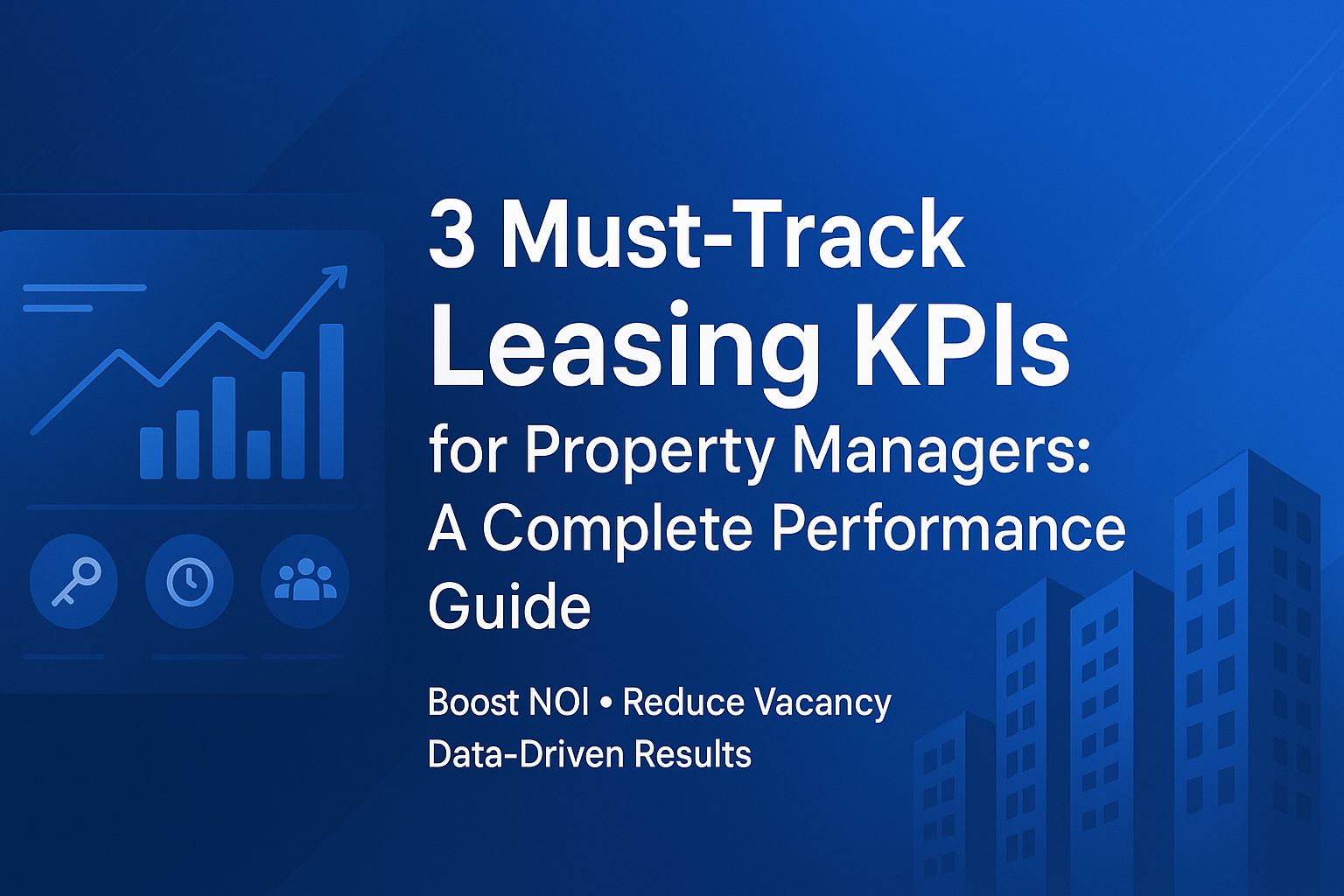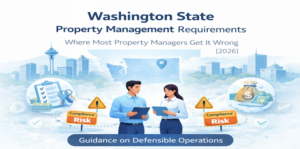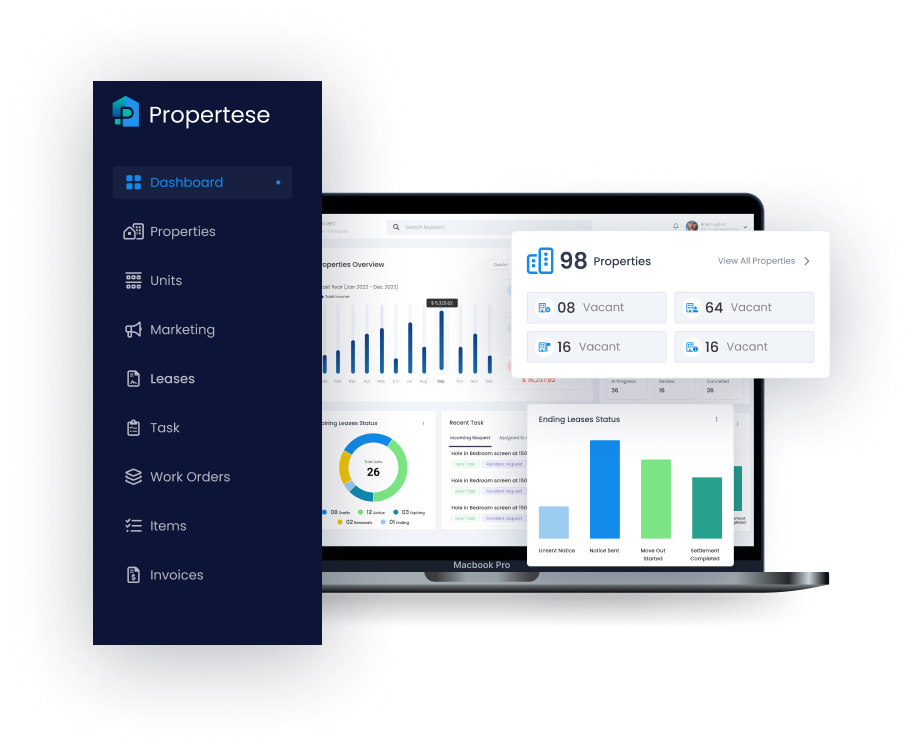
If you’re in charge of a property, you already know this: unoccupied units cost money. A lot of turnover means wasted time. Not renewing hurts your bottom line. Tracking performance is the only way to stay alive in a business where every day of vacancy means lost rent.
This is where leasing KPIs, or Key Performance Indicators, come in. These data, which you can measure, tell you just how well your leasing funnel is doing. They are more than simply spreadsheets or reports; they show you what is working, what is broken, and where money is going.
If you’re new to KPIs in property management, this comprehensive guide on property management KPIs explains why they’re crucial for profitability.
What Are KPIs for Leasing?

Leasing KPIs show how well you handle your leasing cycle, from getting leads to turning units to keeping renters. Leasing performance, turn performance, and renewal performance are the three most essential leasing KPIs for property managers. They measure how well they convert leads, prepare units, and keep tenants. KPIs can:
- Locate leasing funnel bottlenecks.
- Calculate the return on investment for marketing.
- Boost budgeting and forecasting.
- Boost NOI, or net operating income.
For example, converting leads to leases with digital marketing is one area where tracking KPIs helps property managers see which campaigns are paying off.
KPI #1: Leasing Performance (Lead-to-Lease Conversion Rate)
Leasing performance tells you how well you’re turning enquiries into signed leases. It’s the best way to tell how well marketing and sales work. Leasing Performance is significant for the following reasons:
- Shows how well your marketing strategies are working.
- Shows if people are leaving during showings or applications.
- Helps guess what the future occupancy rates will be.
Property managers can enhance leasing performance by tracking lead sources, using online portals, automating follow-ups, and training leasing teams to improve communication and speed up conversions.
Struggling with ads not bringing results? Here’s how effective property management advertising can maximize occupancy.
This formula will help you figure out Leasing Performance:
Leasing Conversion Rate = (Number of Leases ÷ Number of Leads) × 100
For example: If you got 200 leads and signed 20 leases in a month, your leasing conversion rate is 20 ÷ 200 × 100 = 10%.
KPI #2: Turn Performance (Unit Turnover Time)
Turn performance tells you how long it takes to prepare a unit for a new tenant after the current one moves out. The clock starts when the old tenant moves out and stops when the unit is ready for a new tenant. It is critical because:
- Each additional day of vacancy results in lost revenue.
- Faster turnover leads to higher occupancy and improved cash flow.
- It affects tenant satisfaction; nobody likes delays when moving in.
You can improve the turn performance by:
- Checking units before the lease ends to see what needs fixing.
- Making a checklist so that you don’t forget anything.
- Book supplies earlier to avoid delays.
For practical support, many managers use move-out checklists or even smooth move-out process tips to cut delays.
KPI #3: Renewal Performance (Tenant Retention Rate)
Renewal performance shows how many tenants stay in their flat instead of moving out. Different industries have different averages, although many markets consider a renewal rate of 70–80% high. It’s cheaper to renew than to recruit new tenants. Stable tenants mean steady income. A high retention rate means that tenants are happy. You can improve Renewal Performance by:
- Early communication. Contact them 90 days before the lease ends.
- Give people the choice of month-to-month, 12-month, or multi-year plans.
- Offer incentives for renewals, like upgrades, tiny rent cuts, and rewards for being a loyal customer.
- Pay attention to your tenants. Surveys can help you fix problems before it’s time to renew.
For deeper insights, check out our blog on the best tenant retention strategies.
You can calculate renewal performance with this formula:
Renewal Rate = (Number of Renewals ÷ Total Expiring Leases) × 100
Example: Your renewal rate is 80% if 80 out of 100 tenants with leases about to end renew.
What do these three leasing KPIs do together?
According to the National Apartment Association (NAA), turnover costs average $1,000 per unit when you include the expense of cleaning, marketing, and losing a tenant. A reasonable rental conversion rate is between 8% and 15%, which varies by market and property type. Most managers want to turn over a unit in 5 to 7 days, but older properties often take more than 10 days.
A healthy tenant renewal rate is between 70 and 80%, but metropolitan markets tend to have lower rates because people move around more. Monitoring these leasing KPIs is important since they give managers clear performance goals, help them avoid losing money, and help them make better predictions.
Leasing, turning, and renewing performance are integral components of a property’s leasing cycle. They ensure sufficient new renters and reduce turnover and marketing costs.
If retention or customer satisfaction is a challenge, read our blog on resolving issues and retaining residents.
Leasing Made Easy with Propertese
To help you manage all these KPIs more effectively, Propertese has a comprehensive leasing and rental management solution. With Propertese, you can track leads, prepare leases, work on tenant renewals, and manage unit turnovers in one place. You get tools and dashboards that are specifically designed for property managers who want fewer vacancies, faster turnovers, and happier tenants.
Conclusion
Managing property is both a science and an art. You can only guess if you don’t have numbers to help you. By keeping track of leasing, turnover, and renewal performance, you can see where you’re doing well and losing money. Monitor these three leasing KPIs constantly, compare them to benchmarks, and make tiny changes to improve them over time. This will lead to fewer empty units, happier tenants, and more money for the property.
Propertese may help you get the most out of your leasing cycle by giving you the information and automation you need to track KPIs, take action, and make money easily.
Table of Contents
Stay Updated
Subscribe to get the latest news, industry trends, blog posts, and updates...




